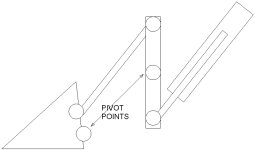MossRoad
Super Moderator
- Joined
- Aug 31, 2001
- Messages
- 66,173
- Location
- South Bend, Indiana (near)
- Tractor
- Power Trac PT425 2001 Model Year
I was talking to my brother-in-law last night about my grapple project and other fun stuff. I mentioned the hydraulic cylinder that I'm planning to use. He told me this little tidbit on hydraulic cylinders that I never knew. Is it true? Seems to hold water...
A typical hydraulic cylinder is stronger on the extend stroke than the retract stroke. Why? Lets say you have a 2" cylinder with a 1" rod. When you extend the cylinder, the hydraulic fluid has a full 2" disk to push on. When you retract, the fluid is pushing on the other side of the disk. The center of the 2" disk is occupied by the end of the 1" shaft that is attached to it. There is less surface area for the fluid to push on, so it is not as "strong".
I never thought of that. Hmmm.
A typical hydraulic cylinder is stronger on the extend stroke than the retract stroke. Why? Lets say you have a 2" cylinder with a 1" rod. When you extend the cylinder, the hydraulic fluid has a full 2" disk to push on. When you retract, the fluid is pushing on the other side of the disk. The center of the 2" disk is occupied by the end of the 1" shaft that is attached to it. There is less surface area for the fluid to push on, so it is not as "strong".
I never thought of that. Hmmm.

